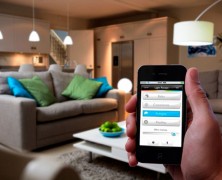How would you like an LED lighting system in your home that matched your body’s natural rhythms, optimizing your mental and emotional well-being? Or how about LED strip lights connected to motion sensors that guide you to the bathroom in the middle of the night? With home automation LED lighting systems, these are fully feasible options for today’s 21st century home owner. A home automation system uses wireless networking technology to program and remotely control common household systems including lighting, appliances, HVAC (heating, ventilation and air conditioning), or the locks of gates and doors, among other common home necessities. Rightfully so, there has been quite a bit of attention given to home automation in recent years. Home automation LED lighting systems, for instance, are more convenient, more energy efficient, and ultimately more exciting than traditional home lighting systems. Such systems exemplify the use of technology for real human benefit, in contrast to many convoluted technological “solutions” that make things even more difficult. Simplicity is a tremendously important feature as the world looks to reduce its carbon footprint through the automation of routine tasks. How do home automation LED lighting systems work? Imagine your home with a full network of LED lights that you can control with an app on your phone or computer. Not quite sure what that would look like? Here are a few examples of the kind of control you would have: Motion sensors turn on/off and dim automated LED lights when you enter or leave rooms Turn off all the interior lights in your home with a simple click of an app button Use your smartphone to remotely monitor and adjust the lighting in your home while away on vacation An intelligent lighting system that turns on the lights at sunset and turns them off...
LED Lighting Health Benefits...
posted by Flexfire LEDs
Earlier this month at the 2014 Consumer Electronics Show, the Rensselear Polytechnic Institute’s Smart Lighting Engineering Research Center demonstrated a personal light measurement system that will assist in accurately monitoring the body’s circadian rhythm. Designed for Google Glass, the prototype captures an individual’s light exposure and biometric signals, then sends this information to an Android app. The app then provides information that will help the individual achieve better sleep cycles, in turn leading to improved overall health and productivity. This project is the latest of many to explore LED lighting health benefits. So what do LED lights have to do with this? Among all light sources, LEDs are unique in that they can be tuned to control light direction, color temperature, and overall illuminance. LEDs thus play a key role in so-called “human-centric lighting”, which examines lighting exposure as a means to address modern health issues. This is particularly relevant given the ever-increasing amount of time we spend indoors, not to mention the fact that many in the Northern Hemisphere live with little to no sunlight each winter. Imagine this: you live in northern Sweden, where prolonged periods without daylight turn you into a depressed, grumpy, unproductive mess. Along comes a device that measures your personal light intake each day, then automatically tells your home lighting system how much and what sort of light your body needs to function properly. Sounds like science fiction, right? Check out RPI’s Healthy Home Project in Sweden. According to a report published in part by LightingEurope, the use of human-centric lighting helps improve sleep, increase productivity, accelerate healing and even prevent some chronic diseases. LEDs promise to play a central part in this exciting new field of research, and it will be interesting to see where this takes us...







